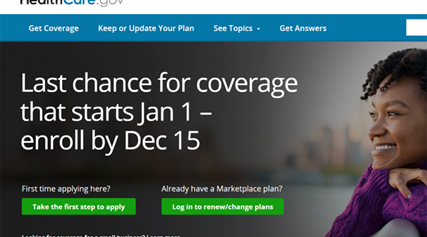MM Curator summary
The article below has been highlighted and summarized by our research team. It is provided here for member convenience as part of our Curator service.
[MM Curator Summary]: Exchange enrollment is up.
The ACA is seen as an alternative for Medicaid coverage as states begin the redetermination process starting April 1.

Photo: HealthCare.gov
Affordable Care Act marketplace enrollment continues to outpace previous years, with nearly 11.5 million people selecting a health plan nationwide as of Dec. 15, the deadline for coverage starting Jan. 1, 2023, according to the Department of Health and Human Services.
About 1.8 million more people have signed up for health insurance, or an 18% increase, from this time last year, HHS said.
In 2022, the number of those signing up through the federal marketplace on HealthCare.gov totaled 10.2 million. Final 2022 enrollment numbers recorded 14.5 million consumers signing up for coverage in all states, with 3 million being new consumers, according to the Centers for Medicare and Medicaid Services snapshot.
The HealthCare.gov Marketplace Open Enrollment remains open until Jan. 15, 2023, for coverage beginning Feb. 1, 2023.
The next snapshot of national plan selections, including state-based marketplaces, will be released Jan. 11, 2023.
WHY THIS MATTERS
HHS credits investment in the Inflation Reduction Act for tax credits that have allowed four out of five HealthCare.gov consumers to find a health plan for $10 a month or less.
“Unprecedented investments lead to unprecedented results,” HHS Secretary Xavier Becerra said. “Under President Biden’s leadership, we have strengthened the Affordable Care Act Marketplace with continued record affordability, robust competition, and historic outreach efforts – and today’s enrollment numbers reflect that.”
Ninety-two percent of HealthCare.gov enrollees will have access to options from three or more insurance companies when they shop for benefits, HHS said. Consumers can compare and select options by creating standardized plans that offer many of the same benefits at the same cost.
THE LARGER TREND
The national uninsured rate reached an all-time low earlier this year, according to HHS.
This means less uncompensated care for hospitals.
One concern that could increase the number of uninsured is the end of the Medicaid continuous enrollment requirement that was put in place under the public health emergency. An estimated 18 million Medicaid beneficiaries could lose their health insurance as states go through the redetermination process for coverage.
With passage of the $1.7 trillion omnibus spending package, states may start processing Medicaid determinations on April 1, whether the PHE is still in place or not.
The ACA is seen as an alternative for beneficiaries who no longer qualify for Medicaid coverage.
Whether those no longer qualifying for Medicaid could immediately jump onto ACA coverage under a Special Enrollment Period is not clear. What is clear is that passage of the omnibus bill severs Medicaid redeterminations from the end of the PHE.
CMS did not comment on the issue but a spokesman there said, “There’s a lot of work ahead for us to do.”
Special Enrollment Period coverage is generally available to those who have had a life event, such as a marriage, divorce, or having or adopting a child. HealthCare.gov directs consumers who have had a life event, other than a loss of coverage, more than 60 days ago and who missed the Special Enrollment Period to contact the Marketplace Call Center at 1-800-318-2596. But COVID-19 is also considered a qualifying reason.
Twitter: @SusanJMorse
Email the writer: SMorse@himss.org
